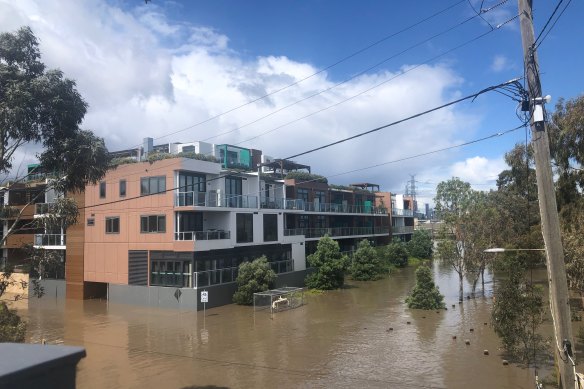By Clay Lucas
Water Minister Harriet Shing says development on floodplains is a key area of review in Melbourne Water’s inquiry into last year’s record-breaking Maribyrnong River flood, despite the water authority already ruling out reviewing “broad planning matters”.
At the same time, more evidence has emerged of how widespread the flood damage was after the Maribyrnong River in Melbourne’s inner west rose to about four metres above its usual height in mid-October.

Brotherhood Books in Kensington lost 21,000 books when its warehouse flooded last October.Credit: Brotherhood Books
While hundreds of homes were inundated in Maribyrnong, Avondale Heights and Ascot Vale in the biggest flood on the river since 1916, more evidence has emerged of the damage floodwater caused homes and businesses in Kensington.
Among them was Brotherhood Books, a Brotherhood of St Laurence social enterprise that sells second-hand titles to raise money for the charity, and aims to keep books out of landfill.
The online business lost 21,000 books when its Kensington warehouse flooded. A Brotherhood spokeswoman said the clean-up took two months because the water was so contaminated and there was so much debris to remove.
The bookseller had since reopened for business and had “more than 40,000 quality used books across a huge range of genres,” the spokeswoman said.

An apartment block in Kensington next to the Maribyrnong River, that was flooded in the deluge.Credit: Denise Jury
Also flooded in Kensington was a 170-unit apartment block next to the Maribyrnong River. There, about 100 cars were water damaged or written off after the building’s basement was deluged. Resident Denise Jury said there was no communication from authorities “prior to, during or after” the flood.
The Age revealed last Monday that a Melbourne Water flood alert system failed to deliver promised warnings during the Maribyrnong River disaster – leaving residents little notice before water rushed into their properties. Jury said residents in her block of apartments had no warning at all.
“Many residents were unable to move their cars prior to the basement flooding,” Jury said. Water levels in the street outside the apartments rose far more quickly than water entering the basement, which meant vehicles could not be moved safely to higher ground despite the basement car park initially remaining protected.
The head of Melbourne Water’s flood inquiry resigned last week after The Age revealed his previous work on a planning panel that recommended changes to flood rules on the Maribyrnong River.

Victorian Water Minister Harriet Shing on Sunday.Credit: Chris Hopkins
At a press conference on Sunday, The Age asked Shing if she would be involved in appointing the new chair of the inquiry. She said she would not.
“This is an independent review and the review of what occurred with the Maribyrnong flooding event needs to be undertaken at arm’s length from government,” she said.
Shing was also asked if she felt a water retarding basin in an area called Arundel, proposed decades ago by a previous state Labor government to minimise flooding on the Maribyrnong River, should be built.
The minister responded that, with increasing climatic volatility, “retarding basins and dams aren’t necessarily going to have the effects that we need them to in relation to keeping water at bay”.
Both the Planning and Environment Act and the Water Act make Melbourne Water responsible for managing development on floodplains, and Shing said the authority’s review would look at this issue.
“Building on floodplains is the key area of concern within this review,” she said of Melbourne Water’s inquiry.
However, the terms of reference for the review specifically exclude broad planning matters including decisions, frameworks and processes.
The review does allow for consideration of topography and population that may have made a material contribution to last year’s floods.
The Age asked Shing’s office about her statement relating to Melbourne Water’s review and whether it would examine building on floodplains.
A spokeswoman for Shing said that at Sunday’s media conference the minister was referring to the geographical area the floodplains were on. “This information helps to inform local planning policy and mitigation measures,” she said.
The terms of reference for Melbourne Water’s review of October’s floods do include recommendations on the authority’s approach to flood modelling and prediction.
The Morning Edition newsletter is our guide to the day’s most important and interesting stories, analysis and insights. Sign up here.